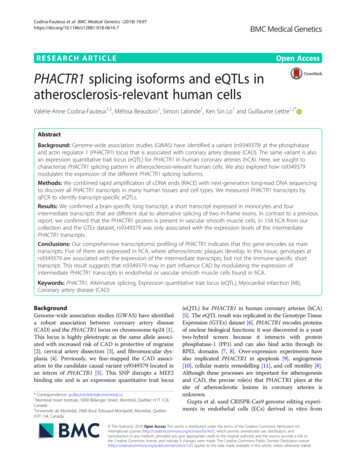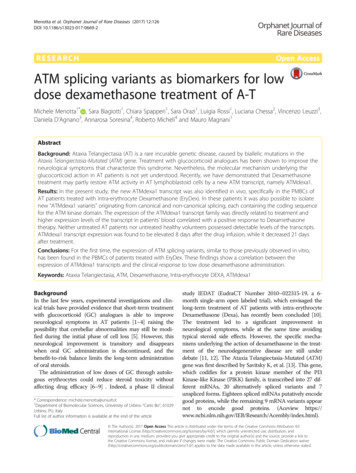
Transcription
Codina-Fauteux et al. BMC Medical Genetics (2018) ARCH ARTICLEOpen AccessPHACTR1 splicing isoforms and eQTLs inatherosclerosis-relevant human cellsValérie-Anne Codina-Fauteux1,2, Mélissa Beaudoin1, Simon Lalonde1, Ken Sin Lo1 and Guillaume Lettre1,2*AbstractBackground: Genome-wide association studies (GWAS) have identified a variant (rs9349379) at the phosphataseand actin regulator 1 (PHACTR1) locus that is associated with coronary artery disease (CAD). The same variant is alsoan expression quantitative trait locus (eQTL) for PHACTR1 in human coronary arteries (hCA). Here, we sought tocharacterize PHACTR1 splicing pattern in atherosclerosis-relevant human cells. We also explored how rs9349379modulates the expression of the different PHACTR1 splicing isoforms.Methods: We combined rapid amplification of cDNA ends (RACE) with next-generation long-read DNA sequencingto discover all PHACTR1 transcripts in many human tissues and cell types. We measured PHACTR1 transcripts byqPCR to identify transcript-specific eQTLs.Results: We confirmed a brain-specific long transcript, a short transcript expressed in monocytes and fourintermediate transcripts that are different due to alternative splicing of two in-frame exons. In contrast to a previousreport, we confirmed that the PHACTR1 protein is present in vascular smooth muscle cells. In 158 hCA from ourcollection and the GTEx dataset, rs9349379 was only associated with the expression levels of the intermediatePHACTR1 transcripts.Conclusions: Our comprehensive transcriptomic profiling of PHACTR1 indicates that this gene encodes six maintranscripts. Five of them are expressed in hCA, where atherosclerotic plaques develop. In this tissue, genotypes atrs9349379 are associated with the expression of the intermediate transcripts, but not the immune-specific shorttranscript. This result suggests that rs9349379 may in part influence CAD by modulating the expression ofintermediate PHACTR1 transcripts in endothelial or vascular smooth muscle cells found in hCA.Keywords: PHACTR1, Alternative splicing, Expression quantitative trait locus (eQTL), Myocardial infarction (MI),Coronary artery disease (CAD)BackgroundGenome-wide association studies (GWAS) have identifieda robust association between coronary artery disease(CAD) and the PHACTR1 locus on chromosome 6p24 [1].This locus is highly pleiotropic as the same allele associated with increased risk of CAD is protective of migraine[2], cervical artery dissection [3], and fibromuscular dysplasia [4]. Previously, we fine-mapped the CAD association to the candidate causal variant rs9349379 located inan intron of PHACTR1 [5]. This SNP disrupts a MEF2binding site and is an expression quantitative trait locus* Correspondence: guillaume.lettre@umontreal.ca1Montreal Heart Institute, 5000 Bélanger Street, Montréal, Québec H1T 1C8,Canada2Université de Montréal, 2900 Boul. Édouard-Montpetit, Montréal, QuébecH3T 1J4, Canada(eQTL) for PHACTR1 in human coronary arteries (hCA)[5]. The eQTL result was replicated in the Genotype-TissueExpression (GTEx) dataset [6]. PHACTR1 encodes proteinsof unclear biological functions: it was discovered in a yeasttwo-hybrid screen because it interacts with proteinphosphatase-1 (PP1) and can also bind actin through itsRPEL domains [7, 8]. Over-expression experiments havealso implicated PHACTR1 in apoptosis [9], angiogenesis[10], cellular matrix remodelling [11], and cell motility [8].Although these processes are important for atherogenesisand CAD, the precise role(s) that PHACTR1 plays at thesite of atherosclerotic lesions in coronary arteries isunknown.Gupta et al. used CRISPR-Cas9 genome editing experiments in endothelial cells (ECs) derived in vitro from The Author(s). 2018 Open Access This article is distributed under the terms of the Creative Commons Attribution 4.0International License (http://creativecommons.org/licenses/by/4.0/), which permits unrestricted use, distribution, andreproduction in any medium, provided you give appropriate credit to the original author(s) and the source, provide a link tothe Creative Commons license, and indicate if changes were made. The Creative Commons Public Domain Dedication o/1.0/) applies to the data made available in this article, unless otherwise stated.
Codina-Fauteux et al. BMC Medical Genetics (2018) 19:97induced pluripotent stem cells to test the effect of genotypes at rs9349379 on the expression of nearby genes [12].In this cellular system, the regulatory element aroundrs9349379 did not modulate the expression of PHACTR1,but controlled the expression of the endothelin-1 (EDN1)gene located 600 kb upstream. EDN1 encodes ET-1, a 21amino acids peptide with a potent vasoconstrictor effectin humans and clear implications for cardiovascular diseases. Paradoxically, rs9349379 is not an eQTL for EDN1in our hCA samples nor in the GTEx dataset [5, 6]. Together, these results raise the possibility that rs9349379might control the expression of both PHACTR1 andEDN1 in different cell types and/or upon different environmental stimuli (e.g. inflammation).For these reasons, we continued to investigate theregulation of PHACTR1 expression in human tissuesand cell types. Consistent with a recent study [13], wereport here a long PHACTR1 transcript expressed in thebrain and a short transcript expressed in the brain, theheart, and monocytes. We also confirmed four intermediate transcripts that are different due to alternativesplicing of two exons. They are co-expressed in tissuesand cells tested. The shorter intermediate transcriptshave a higher expression in the brain, the heart, andmonocytes, whereas the longer intermediate transcriptsare more expressed in ECs and vascular smooth musclecells (VSMCs). Finally, we tested genetic associations between genotypes at rs9349379 and the expression ofPHACTR1 transcripts (or exons) in hCA samples. Ourresults strengthen the link between CAD-associatedrs9349379 and PHACTR1 expression in non-immunecells found in hCA.MethodsCell lines and tissuesWe purchased pooled human umbilical vein endothelialcells (HUVEC; C2519A), human aortic endothelial cells(HAEC; CC-2535), and human coronary artery endothelialcells (HCAEC; CC-2585; Lonza) and cultured them inEBM-2 media supplemented with EGM-2 or EGM2-MVSingleQuot kit. We purchased immortalized HAEC (teloHAEC; CRL-4052; ATCC) and cultured them in vascularcell basal medium supplemented with vascular endothelialcell growth kit and puromycin at 0.3 μg/mL. Human coronary artery smooth muscle cells (HCASMC) and humanaortic smooth muscle cells (HASMC) were obtained fromDr. Tardif’s lab and cultured in medium 231 (M-231-500)supplemented with smooth muscle growth supplement(S-007-25; Gibco). Monocytes were obtained from Dr.Rioux’s lab and we cultured them in RPMI with 10% fetalbovine serum. RNA from tissues was extracted either withthe Ribopure Kit (Ambion) or using EZ1-XL Advance andQiagen EZ1 RNA Tissue Mini Kit. hCA were obtainedfrom the “Réseau d’Échanges de Tissus et d’ÉchantillonsPage 2 of 9Biologiques” (RÉTEB) biorepository at the MontrealHeart Institute and Quebec Heart and Lung Institute. Wepurchased adult brain total RNA (540005–41, lot#6048990)and adult heart total RNA (540011–41, lot#6056165; Agilent Technologies).Rapid Amplification of cDNA Ends (RACE)We extracted total RNA from HUVEC, teloHAEC,HCAEC, HAEC, HCASMC and HASMC P20 (with a passage (P) lower than 8 for primary cells unless specified) cellsgrown to confluence in 100 mm dishes with the RNeasyPlus Mini Kit (Qiagen). For the RACE experiments, we alsoadded RNA from one hCA donor (#ICM167), adult brain,and adult heart. RNA integrity and concentration weremeasured by Agilent RNA 6000 Nano II assays (AgilentTechnologies) on an Agilent 2100 Bioanalyzer. We reversetranscribed 1 μg of total RNA using a modified oligo(dT) primer and the SMARTScribe Reverse Transcriptase(Clontech). We specifically amplified cDNA of PHACTR1using the SMARTer RACE 5′/3’ Kit (Clontech). The genespecific primers are in Additional file 1. The RACE products were purified by gel extraction with the NucleoSpinGel and PCR Clean-Up Kit, cloned in pRACE vector withthe In-Fusion HD Cloning Kit and transformed with StellarCompetent Cells (Clontech). After overnight incubation,plasmids were extracted from single bacterial colonies withQIAprep Spin miniprep kit (Qiagen). We sequencedPHACTR1 inserts by Sanger sequencing using M13 primers(Additional file 1).Long-read Pacific Biosciences (PacBio) sequencing librarypreparationWe produced libraries using 1 μg of total RNA (HUVEC,HAEC, HCAEC, HASMC, HCASMC and brain) and 1 μLof 12 μM dT-Barcode (dT-BC), according to the manufacturer’s protocol (Procedure and checklist-Isoform sequencing using the SMARTer PCR cDNA synthesis kit(Clontech) and no size selection). Each library had its owndT-BC (see Additional file 1 for sequences). Briefly, wesynthesized the first strand of cDNA with the followingthermal profile: 72 C for 3 min, slow ramp to 42 C at0.1 C/sec and 42 C for 2 min. We synthesized cDNAusing the SMARTer PCR cDNA synthesis kit at 42 C for90 min. We performed a large-scale PCR reaction on eachcDNA library with optimization for the numbers of cycleusing the KAPA Hi-Fi PCR kit. As determined with aHigh Sensitivity DNA Chip (Agilent Technologies), weneeded 11 to 13 PCR cycles to obtain 250 ng of eachcDNA. Before capture, we washed cDNA with AMPurePB beads. To enrich for PHACTR1 transcripts, we designed biotinylated capture probes as Ultramers from IDTDNA according to the manufacturer’s protocol (full-lengthcDNA target sequence capture using SeqCap EZ libraries;see Additional file 1 for sequences). We used a total of
Codina-Fauteux et al. BMC Medical Genetics (2018) 19:971.5 μg of cDNA (250 ng from each barcoded cDNA prep)to capture PHACTR1 transcripts. We used six differentblocking oligos, corresponding to the reverse complement sequence of the dT-BC with a 3′ modification(3SpC3)(Additional file 1). After capture, we amplifiedthe library with 14 cycles of PCR using Takara LA TaqDNA polymerase (Clontech). The long-read PacBio sequencing was performed on one SMRTcell with Pacbio RSII at the Genome Quebec/McGill Innovation Center.Reverse transcription polymerase chain reaction (RT-PCR)We extracted RNA from HUVEC, teloHAEC (treated withtumor necrosis factor (TNF)-α at 10 ng/ml for 4 h),monocytes, HCASMC, HASMC, HCAEC, and HAEC asdescribed above. We analyzed unstimulated monocytes, aswell as monocytes stimulated with 10 ng/ml of phorbolmyristate acetate (PMA) for 48 h. Three hours later, someof the PMA-treated monocytes were also treated with lipopolysaccharides (LPS) (100 ng/ml) for one hour. Weused the same adult brain total RNA and adult heart totalRNA as for the RACE (see above). We measured RNAquality and concentration with Agilent RNA 6000 Nano IIassays (Agilent Technologies) on an Agilent 2100 Bioanalyzer. We reverse transcribed 1 μg or less of total RNA(with RNA integrity number of 10 for all cells and above 7for all tissues) using random primers and 1 U of the MultiScribe Reverse Transcriptase (Applied Biosystems) in a20 μL reaction volume at 100 mM dNTPS and 20 U ofRNase inhibitor with these three steps: 10 min at 25 C,120 min at 37 C and 5 min at 85 C. We mixed an equalvolume of cDNA from each sample to create a pool ofcDNA to use as positive control. We amplified fragmentsof PHACTR1 transcripts from these tissues and cell lineswith GoTaq DNA polymerase (Promega) with the following thermal cycle: 95 C for 2 min; 94 C for 30 s, optimaltemperature for 30 s and 72 C for 1 min and 20 s (35times); 72 C for 5 min. We also amplified full PHACTR1open reading frame (ORF) with SeqAmp DNA polymerase (Clontech) with the following thermal cycle: 94 C for1 min; 98 C for 10 s, optimal temperature for 15 s and68 C for 3 min (30 times); 68 C for 5 min. The sequencesof the primers are in Additional file 1. We characterisedthe PCR products by agarose gel electrophoresis.Quantitative polymerase chain reaction (qPCR)We extracted DNA and RNA from 36 hCA samples fromthe RÉTEB. Of these 36 samples, 14 are new and 22 werepreviously analyzed [5]. Genotyping of PHACTR1-rs9349379was performed at the Beaulieu-Saucier PharmacogenomicsCentre of the Montreal Heart Institute on the Illumina Infinium MEGA Consortium v2 BeadChip: nAA 15, nAG 13,nGG 8. We measured RNA integrity and concentrationwith Agilent RNA 6000 Nano II assays (Agilent Technologies) on an Agilent 2100 Bioanalyzer. We reverse transcribedPage 3 of 9exactly 1 μg of total RNA as for the RT-PCR experiments(with RNA integrity number of 6 or above for all samples).We followed the MIQE guidelines to assess quality andreproducibility of our qPCR results [14]. We performedqPCR in triplicates for all samples using: 1.25 μL ofcDNA (1/50 dilution), 5 μL of Platinum SYBR GreenqPCR SuperMix-UDG (Life Technologies) and 3.75 μLof primer pair mix at 0.8 μM on a CFX384 from Biorador Eco Illumina qPCR system (Montreal Biotech). Weused the following thermal profile: 10 min at 95 C, and40 cycles of 30 s at 95 C, 30 s at 55 C and 45 s at 72 C.We carried out melting curve analyses after the amplification process to ensure the specificity of the amplifiedproducts. We also simultaneously performed qPCR reactions with no template controls for each gene to test theabsence of non-specific products. Cq values were determined with the CFX Manager 3.1 (Bio-Rad) software andexpression levels were normalized on the expression levelsof the house-keeping genes TATA-box binding protein(TBP), hypoxanthine-guanine phosphoribosyltransferase(HPRT), and glyceraldehyde 3-phosphate dehydrogenase(GAPDH) using the ΔΔCt method. Based on geNORMprinciples for accurate normalization of qPCR data bygeometric averaging of multiple internal control genes[15], mean M values of 0.5845 and 0.5356 (for two experiments) were generated from the GAPDH, HPRT1, andTBP genes. The primer sequences are in Additional file 1.eQTL analyses using GTEx dataWe downloaded from dbGaP genotypes at PHACTR1rs9349379 and RNA-sequencing (RNA-seq) data from122 hCA samples generated by the GTEx Project [6].We used Trimmomatic (V0.36) on reads with thepaired-end (PE) function to remove adapter sequences(TruSeq3-PE.fa:2:30:10) and to trim low-quality baseswith the following parameters: LEADING:3 TRAILING:3SLIDINGWINDOW:4:15 MINLEN:36. We then performed quality control checks using FastQC (V0.11.5).We aligned reads to the reference human genomesequence (GRCh37) using HISAT2 (V2.0.5) [16]. Weselected reads that mapped to the PHACTR1 locususing BamTools (V2.4.1) with the parameters -region“6:12717037.13288073” -mapQuality “ 30”, and usedSortSam and BuildBamIndex tools from Picard (V1.130)to convert .sam files into .bam files and to build theirindex files. We quantified PHACTR1 expression withStringtie (V1.3.3b) [16] with parameters -G -e -b; for theseanalyses we provided our own GTF file with genomiccoordinates corresponding to the three PHACTR1 transcripts expressed in hCA (Additional file 2). Finally,we used Ballgown (V2.8.4) [16] to extract exon-levelexpression data for eQTL analyses with genotypes atPHACTR1-rs9349379.
Codina-Fauteux et al. BMC Medical Genetics (2018) 19:97Statistical analysesWe normalized PHACTR1 expression data (for full transcripts or exons) from our qPCR experiments or GTExusing inverse normal transformation. Using linear regression in R, we tested the association between PHACTR1 expression levels and genotypes at PHACTR1-rs9349379(additive coding), correcting for sex, RNA integrity number(RIN), and the recruitment center (Montreal or Quebeccity) when available.Western blotTo detect PHACTR1 protein expression in VSMCs,0.75 106 and 1 106 of cryopreserved HASMC andHCASMC cells, respectively, were pelleted and directlylysed in RIPA buffer (50 mM Tris-HCl, pH 7.4, 1%NP-40, 0.25% Na-deoxycholate, 0.1% SDS, 150 mMNaCl) containing protease inhibitor cocktail (Sigma),phosphatase inhibitor cocktail 2 and 3 (Sigma), and1 mM PMSF. As controls, teloHAEC were transfectedwith 20 nM of scramble (Santa Cruz, sc-37,007) orPHACTR1 (Santa Cruz, sc-95,456) small interferingRNA (siRNA) in 2 mL of siRNA transfection medium(Santa Cruz, sc-36,868) for 4 h using siRNA TransfectionReagent (Santa Cruz, sc-29,528), and then grown for48 h before cell lysis and protein extraction. Homogenized lysates were clarified by centrifugation to eliminateinsoluble cell debris. We determined protein concentration with a Pierce BCA Protein Assay Kit (ThermoFisher)and prepared samples containing 30 μg of proteins in a600 mM DTT reducing buffer that was denatured 5 minat 95 C prior to loading on a 8% polyacrylamide gel (running buffer: 25 mM Tris base; 192 mM glycine; 0.1%SDS). We transferred proteins onto nitrocellulose membranes in Towbin buffer (25 mM Tris base; 192 mM glycine, 20% (v/v) methanol) and incubated them for 1.5 h inthe blocking buffer (1 TBS, 0.1% Tween-20, 5% milk) atroom temperature. We then incubated membranes withprimary antibodies against PHACTR1 (1:1000; customantibody generated by Biomatik) or GAPDH (1:10,000;Cell Signaling, #2118) at 4 C overnight. For the secondaryantibody, we incubated membranes with horseradishperoxidase-conjugated anti-rabbit IgG (1:10,000; GEHealthcare, NA934) at room temperature for 1 h. The immunoblotting signal was revealed with the SuperSignalwest Pico PLUS chemiluminescent substrate (Thermoscientific, 34,580) and visualized with the ChemiDocTouch system (Bio-Rad).ResultsSix PHACTR1 transcripts in human cells and tissuesPublic databases (e.g. ENSEMBL, Gencode, GTEx) report 10 different PHACTR1 mRNA transcripts expressed inhuman samples. To confirm these results and comprehensively characterize the different PHACTR1 transcriptsPage 4 of 9expressed in humans, we combined RACE and long-readnext-generation (PacBio) DNA sequencing experiments inmany cell types and tissues. These two complementary approaches generated highly concordant results that we alsovalidated by sequencing of the whole ORF. Althoughwe did identify a large number of PHACTR1 transcriptsdue to alternative splicing of non-coding 5′ and 3′ untranslated exons (Additional file 3), our transcriptomicprofiling indicates that PHACTR1 can give rise to sixmain different transcripts that would encode sixproteins based on their coding sequences (Fig. 1andAdditional file 4). The long transcript (1743-bp) encodesa protein of 580 amino acids (Fig. 1). We confirmed fourintermediate transcripts that are different due to the inclusion of the alternatively spliced exons 7.8 and 10.11 (Fig. 1).Both alternative exons are in-frame and add respectively279- (exon 7.8) and 207-bp (exon 10.11) to the ORF.Intermediate transcripts A (1953-bp) and B (1674-bp)include exon 10.11 and encode proteins of 650 and 557amino acids. Intermediate transcripts A- (1746-bp) andB- (1467-bp) exclude exon 10.11 and encode proteinsof 581 and 488 amino acids. Finally, we confirmed ashort transcript (435-bp) encoding a protein of 144 aa(Fig. 1). Its start codon is located in exon 14, 83-bpupstream of the 3′ splice site for the long and intermediate transcripts (Additional file 5).PHACTR1 transcripts are differentially expressedWe used the sequence of the six PHACTR1 transcriptsto design transcript-specific pairs of primers and carriedout RT-PCR experiments on mRNA extracted from human brain, heart, monocytes, ECs, and VSMCs (Fig. 2).The long transcript, which never included exons 7.8 nor10.11, was only expressed in the brain [7]. In contrast,both intermediate transcripts B were expressed in allsamples tested, although we noted that the inclusion ofexon 10.11 varied from one sample to the other. Intermediate transcript B was more abundant in ECs andVSMCs, whereas intermediate transcript B- was themajor intermediate transcript expressed in the brain, theheart, and in monocytes (Fig. 2, third pan
Technologies) on an Agilent 2100 Bioanalyzer. We reverse transcribed 1 μg of total RNA using a modified oligo (dT) primer and the SMARTScribe Reverse Transcriptase (Clontech). We specifically amplified cDNA of PHACTR1 using the SMARTer RACE 5 ′/3’ Kit (Clontech). The ge











